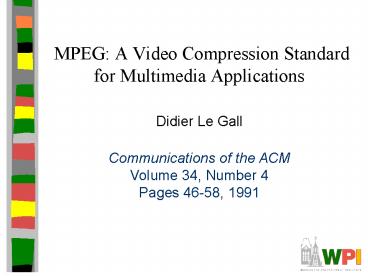MPEG: A Video Compression Standard for Multimedia Applications - PowerPoint PPT Presentation
Title:
MPEG: A Video Compression Standard for Multimedia Applications
Description:
MPEG: A Video Compression Standard for Multimedia Applications Didier Le Gall Communications of the ACM Volume 34, Number 4 Pages 46-58, 1991 – PowerPoint PPT presentation
Number of Views:248
Avg rating:3.0/5.0
Title: MPEG: A Video Compression Standard for Multimedia Applications
1
MPEG A Video Compression Standard for
Multimedia Applications
- Didier Le Gall
Communications of the ACM Volume 34, Number
4Pages 46-58, 1991
2
Outline
- Introduction ?
- MPEG Goals
- MPEG Details
- Performance and Such
- Summary
3
Introduction
- 1980s technology made possible full-motion video
over networks - Television and Computer Video seen moving closer
- (Today, Sony and Microsoft are squaring off)
- Needed a standard
- Often trigger needed volume production
- Ala facsimile (fax)
- Avoid de facto standard by industry
- 1988, Established the Motion Picture Experts
Group (MPEG) - Worked towards MPEG-1
- Primarily video but includes audio (MP3)
4
The Need for Video Compression
- High-Definition Television (HDTV)
- 1920x1080
- 30 frames per second (full motion)
- 8 bits for each three primary colors (RGB)
- ?Total 1.5 Gb/sec!
- Each cable channel is 6 MHz
- Max data rate of 19.2 Mb/sec
- Reduced to 18 Mb/sec w/audio control
- ?Compression rate must be 801!
5
Compatibility Goals
- CD-ROM and DAT key storage devices
- 1-2 Mbits/sec for 1x CD-ROM
- Two types of application videos
- Asymmetric (encoded once, decoded many)
- Video games, Video on Demand
- Symmetric (encoded once, decoded once)
- Video phone, video mail
- (How do you think the two types might influence
design?) - Video at about 1.5 Mbits/sec
- Audio at about 64-192 kbits/channel
6
Requirements
- Random Access, Reverse, Fast Forward, Search
- At any point in the stream (within ½ second)
- Can reduce quality somewhat during this task, if
needed - Audio/Video Synchronization
- Robustness to errors
- Not catastrophic if some bits are lost
- Lends itself to Internet streaming
- Coding/Decoding delay under 150ms
- For interactive applications
- Editability
- Modify/Replace frames
7
Relevant Standards
- Joint picture Experts Group (JPEG)
- Compress still images only
- Expert Group on Visual Telephony (H.261)
- Compress sequence of images
- Over ISDN (64 kbits/sec)
- Low-delay
- Other high-bandwidth H standards
- H21 (34 Mbits/sec)
- H22 (45 Mbits/sec)
8
Outline
- Introduction (done)
- MPEG Goals (done)
- MPEG Details ?
- Performance and Such
- Summary
9
MPEG Compression
- Compression through
- Spatial
- Temporal
10
Spatial Redundancy
- Take advantage of similarity among most
neighboring pixels
11
Spatial Redundancy Reduction
- RGB to YUV
- less information required for YUV (humans less
sensitive to chrominance) - Macro Blocks
- Take groups of pixels (16x16)
- Discrete Cosine Transformation (DCT)
- Based on Fourier analysis where represent signal
as sum of sine's and cosines - Concentrates on higher-frequency values
- Represent pixels in blocks with fewer numbers
- Quantization
- Reduce data required for co-efficients
- Entropy coding
- Compress
12
Spatial Redundancy Reduction
Intra-Frame Encoded
Zig-Zag Scan, Run-length coding
13
Groupwork
- When may spatial redundancy reduction be
ineffective? What kinds of images/movies?
14
Groupwork
- When may spatial redundancy reduction be
ineffective? - High-resolution images and displays
- May appear coarse
- A varied image or busy scene
- Many colors, few adjacent
15
Loss of Resolution
Original (63 kb)
Low (7kb)
Very Low (4 kb)
16
Temporal Redundancy
- Take advantage of similarity between successive
frames
17
Temporal Activity
Talking Head
18
Temporal Redundancy Reduction
19
Temporal Redundancy Reduction
20
Temporal Redundancy Reduction
- I frames are independently encoded
- P frames are based on previous I, P frames
- B frames are based on previous and following I
and P frames - In case something is uncovered
21
Group of Pictures (GOP)
- Starts with an I-frame
- Ends with frame right before next I-frame
- Open ends in B-frame, Closed in P-frame
- (What is the difference?)
- MPEG Encoding parameter, but typical
- I B B P B B P B B I
- I B B P B B P B B P B B I
- Why not have all P and B frames?
22
Groupwork
- When may temporal redundancy reduction be
ineffective?
23
Groupwork
- When may temporal redundancy reduction be
ineffective? - Many scene changes
- High motion
24
Non-Temporal Redundancy
- Many scene changes vs. Few scene changes
25
Non-Temporal Redundancy
- Sometimes high motion
26
Typical MPEG Parameters
27
Typical Compression Performance
- Type Size Compression
- ---------------------
- I 18 KB 71
- P 6 KB 201
- B 2.5 KB 501
- Avg 4.8 KB 271
- ---------------------
- Note, results in Variable Bit Rate, even if
frame rate is constant
28
MPEG Today
- MPEG video compression widely used
- digital television set-top boxes
- HDTV decoders
- DVD players
- video conferencing
- Internet video
- ...
29
MPEG Today
- MPEG-2
- Super-set of MPEG-1
- Rates up to 10 Mbps (720x486)
- Can do HDTV (no MPEG-3)
- MPEG-4
- Around Objects, not Frames
- Lower bandwidth
- Has some built-in repair
- MPEG-7
- Not (yet) a standard
- Allows content-description (ease of searching)
- MP3
- For audio
- MPEG Layer-3
30
MPEG Tools
- MPEG tools at
- http//www-plateau.cs.berkeley.edu/mpeg/index.html
- MPEG streaming at
- http//www.comp.lancs.ac.uk/































